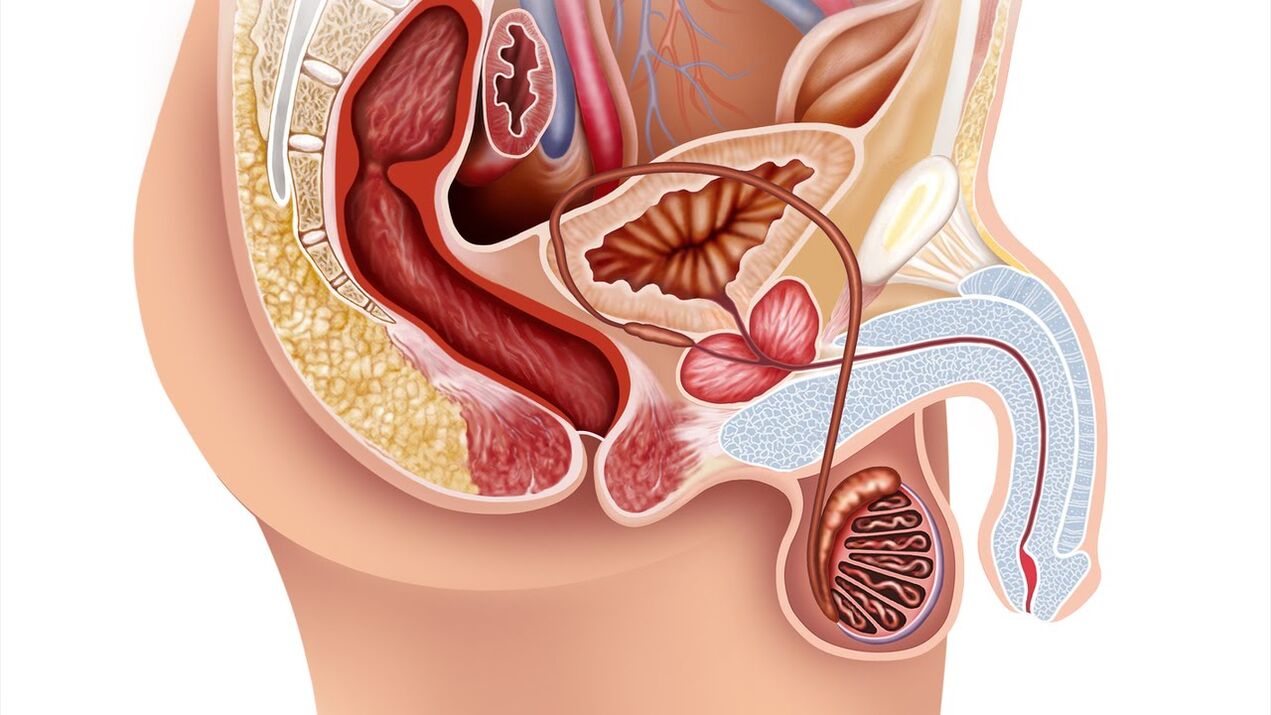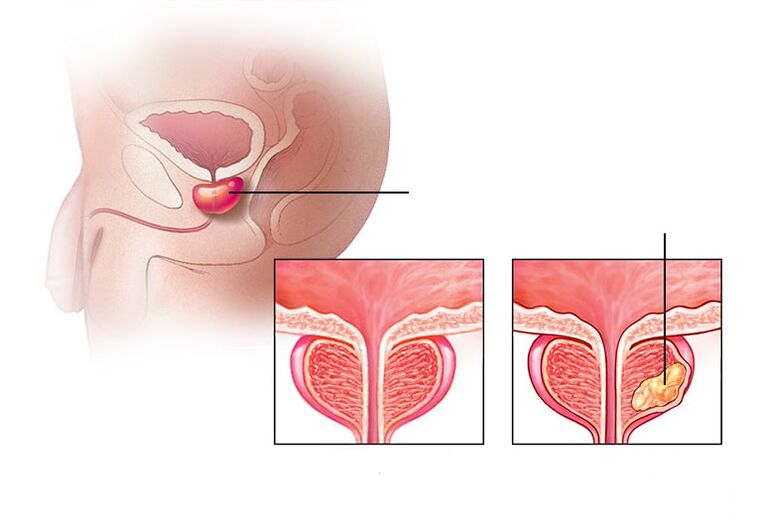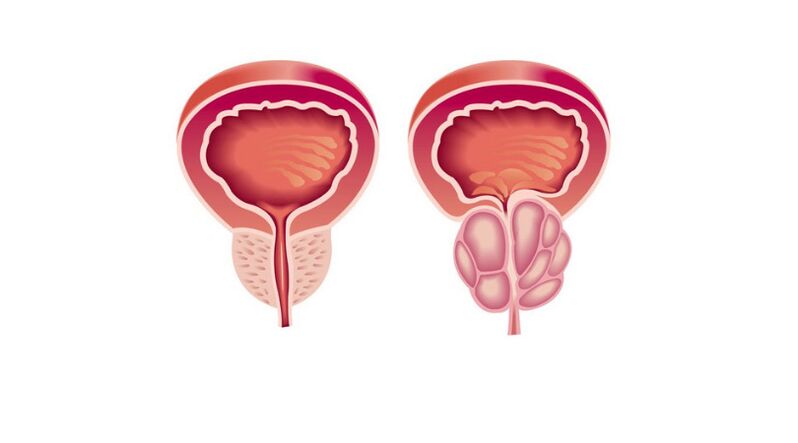
Prostatitis is an inflammatory process associated with inflammation of the prostate gland (prostate) in men. Most often this disease occurs in men over 30 years. This condition causes pain in the lower back, perineum or pelvic area, is accompanied by a violation of the normal process of urination and, in severe forms, leads to erectile dysfunction and serious problems in relationships with a partner.
About a quarter of cases among infertile couples are precisely the causes of the male factor that affects the inability to conceive. Male infertility is a violation of the quality of sperm and their quantitative content in ejaculation.

The prostate gland (prostate) refers to the male reproductive system. It is chestnut-shaped, located in front of the rectum, below the bladder and surrounds the urethra (urethra). When the prostate gland becomes inflamed, it compresses the urethra, which further leads to problems with urination. The main function of the prostate is to produce a secretion (fluid) that is part of the sperm and dilutes it, which ensures the normal motility of the sperm.
Prostatitis is very common in the urologist's office. It can appear suddenly or gradually, appearing continuously and for a long time (chronic prostatitis). The chronic form of this disease is more common than the acute form. Chronic prostatitis ranks fifth among the twenty major urological diagnoses.
As prostatitis is an active source of infection in the body, it requires mandatory treatment, even if its symptoms do not bother you.
Reasons for developing prostatitis
The list of causes of prostate inflammation is very different:
- diseases of the urogenital system (cystitis, urethritis, pyelonephritis).
- sexually transmitted infections (trichomoniasis, gonorrhea).
- infections associated with pneumonia, influenza, tonsillitis, furulitis.
- chronic constipation, forcing a man to strain regularly.
- sedentary lifestyle and irregular sex life, leading to stagnation of the secret.
- urinary retention - an enlarged bladder increases pressure on the prostate.
- frequent hypothermia (or overheating).
- pelvic injuries.
- hormonal disorders that weaken the immune system.
Very often, the appearance of prostatitis is caused by pyogenic microbes: E. coli, streptococci and staphylococci, mycoplasma, fungi Candida, Trichomonas, tuberculosis bacillus. They multiply very quickly and destroy the prostate tissue, which is manifested by inflammation.
In most cases, the appearance of prostatitis causes an infection that penetrates the prostate gland through the urethra. It happens that it enters the body through the blood or lymph, passes through the bladder or rectum.
Great! Decreased immunity is very dangerous for a patient with chronic prostatitis, as the prostate gland quickly becomes inflamed with fatigue, stress, lack of sleep, malnutrition and other adverse factors.
With a sedentary lifestyle and the absence of a continuous sexual life, the blood supply to the pelvic organs deteriorates, leading to oxygen starvation of the prostate tissues and congestion. A stationary secretion is an ideal environment for the growth of pathogenic microorganisms that cause inflammation.

Types and forms of prostatitis
Prostatitis, depending on the cause of the disease, is classified into types and forms:
By species are distinguished:
Bacterial prostatitisInflammation caused by infection. Bacterial prostatitis occurs in both young and old men.
congestive prostatitisInflammation caused by stagnant secretions. It develops in men with a sedentary lifestyle who do not have a regular sex life. This form can be quickly supplemented by an infection and then the stagnant process is complicated by the bacterial form.
Accounting prostatitis- stones form in the prostate gland. Chronic prostatitis without treatment can cause this complication. This disease affects older men who have not followed the advice of a urologist.
Depending on the form of flow, there are:
Acute form of prostatitisInflammation of the prostate gland caused by an infectious agent, characterized by the appearance of edema and purulent foci in the tissues. 30-58% of men of reproductive age (30-50 years) face such a diagnosis.
Chronic form of prostatitischaracterized by persistent or recurrent urogenital symptoms caused by a bacterial infection in the prostate gland. The chronic form occupies 10% of all cases of prostatitis.
Symptoms of prostatitis
Generalsymptoms of inflammation of the prostateis:
- lumbar pain;
- sensations of discomfort during intestinal motility.
- pain in the perineal or pelvic area.
- disorders of the lower urinary tract.
The acute stage of prostatitis is accompanied by general intoxication syndrome. This disease is characterized by a strong manifestation of symptoms with a strong clinical picture:
- sudden rise in body temperature, chills, nausea, vomiting and malaise.
- pain syndrome and chills in the joints and muscles.
- increase in the size of the prostate and the appearance of discomfort in the perineal area.
- frequent urination and urinary retention.
As part of individual inflammatory processes, a purulent-septic disease that affects the blood may develop. In such a situation, the patient must be treated urgently: with sepsis, the treatment of prostatitis must be carried out exclusively in the clinic.
In thechronic prostatitis of bacterial naturesymptoms are usually absent, so treatment begins only when a urinary tract infection is detected, which manifests itself in the background of a complication of the disease. In this case, you can observe:
- pain during ejaculation;
- the appearance of blood in the ejaculate.
- the presence of secretions from the urethra.
- erectile dysfunction may develop.
If the examination did not show that the chronic pain is caused by pathologies in the prostate, then in this case we are dealing withchronic non-bacterial prostatitisor the so-calledchronic pelvic pain syndrome. With this disease, a man's quality of life is significantly reduced, as it leads to various disorders of psychological and sexual nature:
- increased fatigue;
- a feeling of weakness;
- erectile dysfunction?
- painful ejaculation;
- pain after intercourse etc.
Similar symptoms may apply to other urological conditions, so it is impossible to diagnose prostatitis with symptoms alone. For example, urinary disorders and pain are present in prostate adenoma, cystitis, various oncological tumors in the urogenital organs, etc.
Diagnosis of prostate inflammation
Having detected the first signs of the inflammatory process of the prostate, the patient should immediately contact a doctor - a urologist. The doctor must rule out many diseases that have similar manifestations and determine what type of disease it belongs to.
To confirm that the patient has no other diseases (for example, appendicitis, oncology, inflammatory processes in the bladder and kidneys, prostate adenoma), the doctor must perform the necessary tests:
- collection of memories (patient's question).
- general inspection;
- rectal examination;
- study of the secretory prostate gland.
- analysis for sexually transmitted infections.
- ultrasound examination of the prostate, scrotum and pelvic organs.
At the appointment, the urologist should explain to the patient the duration of the clinical manifestations of the disease, the location and nature of the pain (for example, in the perineum, scrotum, penis and inside of the thigh), characteristic changes in sperm(presence of pus and blood).
The doctor diagnoses chronic bacterial prostatitis with symptoms lasting at least three months.
The research will include:
- Digital rectal examination of the gland to determine the degree of prostate enlargement and its cohesion.
- Prostate secretion, urine and / or ejaculation tests.
- Identification of urogenital infection.
- Urodynamic study.
- Ultrasound examination of the urinary system (kidney, prostate, bladder with determination of urine residues).
- Cultural study of prostate secretion and microscopy of various portions of urine and prostatic secretion.
- Androflor is a comprehensive study of the microbiocenosis of the urogenital system in men with PCR, which will determine the qualitative and quantitative composition of the microflora.
Once the cause of the disease has been identified, the doctor will recommend a course of treatment. We must remember that standard methods in only 5-10% of cases can detect an infection, which eventually leads to prostatitis.
The patient must definitely undergo a thorough diagnosis, because the success of the treatment will depend on the accuracy of the results.
Treatment of prostatitis
Once a urologist has made a diagnosis, determined the cause and form of prostatitis, he must prescribe treatment.
The leading role in the treatment of this disease is attributed to drug treatment:
Antibacterial therapy
In the first stage of therapeutic treatment, it is necessary to eliminate the inflammation. Antibiotics are the main treatment for acute bacterial prostatitis and are recommended for chronic bacterial prostatitis. The doctor chooses an antibacterial drug depending on which bacteria caused the disease. The patient should take oral antibiotics over a course of 4-6 weeks. Chronic or recurrent prostatitis takes longer to resolve. Hospitalization may be required for very severe events, where intravenous antibiotic therapy will be given. This usually happens with acute bacterial prostatitis.
Treatment with alpha1-inhibitors
With difficulty urinating, your doctor may prescribe alpha-blockers, which help to facilitate urination and relax the muscles of the prostate and bladder. Muscle relaxants will relieve the pain caused by the swelling of the prostate gland, which puts pressure on the adjacent muscles. Non-steroidal anti-inflammatory drugs (NSAIDs) will help relieve the painful syndrome.
Also, the doctor may prescribe ancillary drugs: biostimulants, extracts of various plants and insects in the form of rectal suppositories. Unfortunately, the use of drugs alone in the treatment of prostatitis remains insufficient.
In the treatment of this disease, the principles of the sequence of actions must be observed. The treatment of prostatitis is always complex.
Physiotherapy in the treatment of prostatitis
In the categories of chronic prostatitis, you can also use physiotherapy methods:
- prostate gland massage (prostate).
- laser treatment;
- microwave hyperthermia and heat therapy.
- electrical stimulation with modulated currents with skin or rectal electrodes.
- acupuncture (acupuncture).
Alternative methods, such as irudotherapy (treatment with medical leeches), are sometimes used to treat prostatitis, but the effectiveness and safety of this method has not been proven.
Stem cell introduction
Cell therapy (stem cell injections) is a very promising method for the treatment of prostatitis today, it is in the early stages of development. Regarding the injection of stem cells into the prostate, one can only have hypotheses about its mechanisms and empirical data obtained from individual groups of researchers.
Surgical treatment of prostatitis
Surgical methods are used to treat the complications of prostatitis (abscess and swelling of the seminal vesicles).
Treatment of chronic pelvic pain syndrome requires a separate examination. Asymptomatic inflammatory prostatitis does not require treatment.
Diet and lifestyle for prostatitis
Prostatitis does not require a special diet, but eating plenty of vegetables, lean meats and dairy products will help improve bowel function. It is necessary to enrich your body with a sufficient amount of fiber, foods rich in vitamin E (wheat germ, corn oil, etc. ), to replace sugar with natural honey. Proper nutrition with inflammation of the prostate gland will help improve bowel function and reduce the chance of recurrence or speed up recovery. The patient should limit himself to coffee, exclude alcohol, drink plenty of fluids and follow a healthy lifestyle.
Preventive measures to prevent prostatitis
When a man follows the right lifestyle: follows a proper diet, engages in sports, then the chances of developing chronic prostatitis are very small. Denial of bad habits and casual sex is the prevention of this disease.
Great! There is primary and secondary prevention to prevent the development of prostatitis in men.
Primary- in order to prevent the occurrence of the disease. It has to do with maintaining a balanced diet, shape of physical activity, timely treatment of any infectious diseases of the body and regular protected sexual intercourse, etc.
Secondary- aims to prevent recurrence of existing chronic prostatitis and provides regular examination by a urologist and preventive treatment with multivitamins, rehabilitation drugs and sports.





























